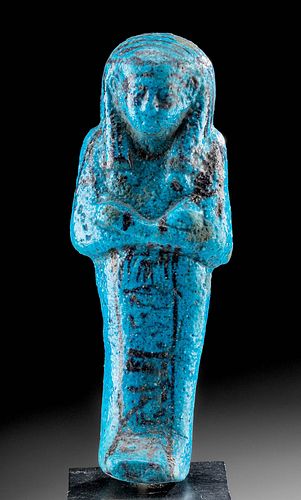Translated Egyptian Faience Ushabti Museum-Exhibited
About Seller
686 S Taylor Ave, Ste 106
Louisville, CO 80027
United States
Selling antiquities, ancient and ethnographic art online since 1993, Artemis Gallery specializes in Classical Antiquities (Egyptian, Greek, Roman, Near Eastern), Asian, Pre-Columbian, African / Tribal / Oceanographic art. Our extensive inventory includes pottery, stone, metal, wood, glass and textil...Read more
Two ways to bid:
- Leave a max absentee bid and the platform will bid on your behalf up to your maximum bid during the live auction.
- Bid live during the auction and your bids will be submitted real-time to the auctioneer.
Bid Increments
| Price | Bid Increment |
|---|---|
| $0 | $25 |
| $300 | $50 |
| $1,000 | $100 |
| $2,000 | $250 |
| $5,000 | $500 |
| $10,000 | $1,000 |
| $20,000 | $2,500 |
| $50,000 | $5,000 |
| $100,000 | $10,000 |
| $200,000 | $20,000 |
About Auction
Nov 16, 2023
Museum-worthy examples of classical antiquities (Egyptian, Greek, Roman, Near Eastern), Viking, Far East / Asian, Pre-Columbian, African / Tribal, Oceanic, Native American, Spanish Colonial, Nautical, Fossils, Ancient Jewelry, Fine / Visual Arts, so much more! Artemis Fine Arts info@artemisfinearts.com
- Lot Description
Ancient Egypt, Third Intermediate Period, 21st Dynasty, ca. 1070 to 943 BCE. A breathtaking example of a hand-built faience ushabti, standing in a dignified pose, that is enrobed in layers of incredibly lustrous, brilliant blue glaze. The figure presents in characteristic ushabti fashion by standing in mummiform with fused legs and feet, crossing both arms atop the chest with a pair of black-painted picks in his hands, and with a seed bag draped from both shoulders down to the middle of his back. The protruding visage exhibits gently modeled features like almond-shaped eyes outlined heavily with black pigment, a flush nose, a slender mouth with indented corners, and tall ears, all framed within the striated lappets of his tripartite wig. A column of hieroglyphic symbols down the front and onto feet reads "The Illuminate, the Osiris, the Chantress of Amon, Ta-Uja." Size: 1.75" W x 4.56" H (4.4 cm x 11.6 cm); 6.25" H (15.9 cm) on included custom stand.
Shabti (or ushabti) dolls are figures shaped like adult male or female mummies wearing traditional ancient Egyptian headdresses. The ancient Egyptians believed that after they died, their spirits would have to work in the "Field of Reeds" owned by the god of the underworld, Osiris. This meant doing agricultural labor, which was required by all members of society, from workers to pharaohs. The wealthier nobility in Egyptian society were able to have shabtis made of coveted faience, and blue faience was meant to reflect the color of the river Nile both on earth and in the afterlife.
Cf. Lieblein 2544, No. 144.
Provenance: private collection of Dr. W. Benson Harer, Los Angeles, California, USA, purchased from Superior Gallery, Los Angeles, California, USA, in 1976; ex-MIA (Minneapolis Institute of Art), 1916; ex-Drexel Museum, Philadelphia, Pennsylvania, USA, 1895 to 1915; ex-A. Drexel collection; ex-Emil Brugsch, Bulaq Museum, Cairo, Egypt, 1894
All items legal to buy/sell under U.S. Statute covering cultural patrimony Code 2600, CHAPTER 14, and are guaranteed to be as described or your money back.
A Certificate of Authenticity will accompany all winning bids.
We ship worldwide and handle all shipping in-house for your convenience.
#182098Condition
Intact and excellent condition. Hole at base for insertion into modern wooden stand. Interestingly, there is an indention on reverse just below the wig that was probably created in the firing process/ mold. The black pigment continues through this area and it is not a repair, but a natural part of the figure.
- Shipping Info
-
All shipping is handled in-house for your convenience. Your invoice from Artemis Gallery will include shipping calculation instructions. If in doubt, please inquire BEFORE bidding for estimated shipping costs for individual items.
-
- Buyer's Premium



 EUR
EUR CAD
CAD AUD
AUD GBP
GBP MXN
MXN HKD
HKD CNY
CNY MYR
MYR SEK
SEK SGD
SGD CHF
CHF THB
THB















